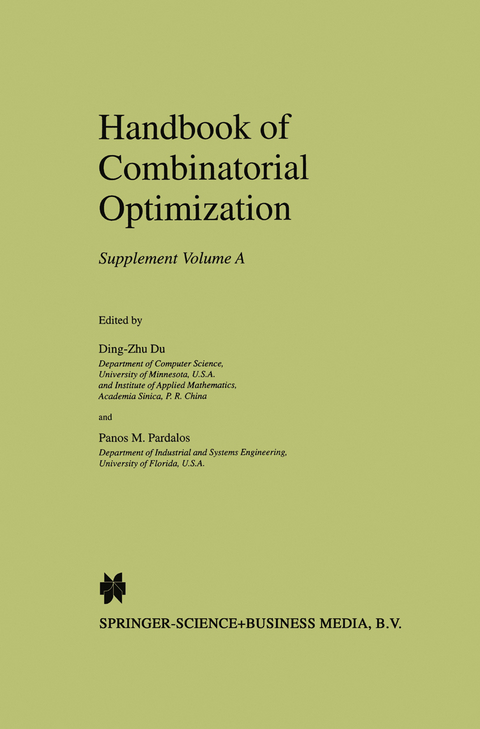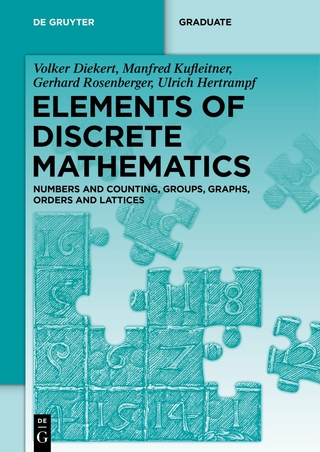
Handbook of Combinatorial Optimization
Supplement Volume A
Seiten
1999
Springer (Verlag)
978-0-7923-5924-1 (ISBN)
Springer (Verlag)
978-0-7923-5924-1 (ISBN)
Furthermore, combinatorial optimization problems occur in many diverse areas such as linear and integer programming, graph theory, artificial intelligence, and number theory. Many polynomial-time solvable combinatorial optimization problems are special cases of linear programming (e.g.
Combinatorial (or discrete) optimization is one of the most active fields in the interface of operations research, computer science, and applied math ematics. Combinatorial optimization problems arise in various applications, including communications network design, VLSI design, machine vision, air line crew scheduling, corporate planning, computer-aided design and man ufacturing, database query design, cellular telephone frequency assignment, constraint directed reasoning, and computational biology. Furthermore, combinatorial optimization problems occur in many diverse areas such as linear and integer programming, graph theory, artificial intelligence, and number theory. All these problems, when formulated mathematically as the minimization or maximization of a certain function defined on some domain, have a commonality of discreteness. Historically, combinatorial optimization starts with linear programming. Linear programming has an entire range of important applications including production planning and distribution, personnel assignment, finance, alloca tion of economic resources, circuit simulation, and control systems. Leonid Kantorovich and Tjalling Koopmans received the Nobel Prize (1975) for their work on the optimal allocation of resources. Two important discover ies, the ellipsoid method (1979) and interior point approaches (1984) both provide polynomial time algorithms for linear programming. These algo rithms have had a profound effect in combinatorial optimization. Many polynomial-time solvable combinatorial optimization problems are special cases of linear programming (e.g. matching and maximum flow). In addi tion, linear programming relaxations are often the basis for many approxi mation algorithms for solving NP-hard problems (e.g. dualheuristics).
Combinatorial (or discrete) optimization is one of the most active fields in the interface of operations research, computer science, and applied math ematics. Combinatorial optimization problems arise in various applications, including communications network design, VLSI design, machine vision, air line crew scheduling, corporate planning, computer-aided design and man ufacturing, database query design, cellular telephone frequency assignment, constraint directed reasoning, and computational biology. Furthermore, combinatorial optimization problems occur in many diverse areas such as linear and integer programming, graph theory, artificial intelligence, and number theory. All these problems, when formulated mathematically as the minimization or maximization of a certain function defined on some domain, have a commonality of discreteness. Historically, combinatorial optimization starts with linear programming. Linear programming has an entire range of important applications including production planning and distribution, personnel assignment, finance, alloca tion of economic resources, circuit simulation, and control systems. Leonid Kantorovich and Tjalling Koopmans received the Nobel Prize (1975) for their work on the optimal allocation of resources. Two important discover ies, the ellipsoid method (1979) and interior point approaches (1984) both provide polynomial time algorithms for linear programming. These algo rithms have had a profound effect in combinatorial optimization. Many polynomial-time solvable combinatorial optimization problems are special cases of linear programming (e.g. matching and maximum flow). In addi tion, linear programming relaxations are often the basis for many approxi mation algorithms for solving NP-hard problems (e.g. dualheuristics).
The Maximum Clique Problem.- Linear Assignment Problems and Extensions.- Bin Packing Approximation Algorithms: Combinatorial Analysis.- Feedback Set Problems.- Neural Networks Approaches for Combinatorial Optimization Problems.- Frequency Assignment Problems.- Algorithms for the Satisfiability (SAT) Problem.- The Steiner Ratio of Lp-planes.- A Cogitative Algorithm for Solving the Equal Circles Packing Problem.- Author Index.
| Erscheint lt. Verlag | 31.10.1999 |
|---|---|
| Zusatzinfo | VIII, 648 p. |
| Verlagsort | Dordrecht |
| Sprache | englisch |
| Maße | 156 x 234 mm |
| Themenwelt | Mathematik / Informatik ► Mathematik ► Graphentheorie |
| Mathematik / Informatik ► Mathematik ► Wahrscheinlichkeit / Kombinatorik | |
| ISBN-10 | 0-7923-5924-0 / 0792359240 |
| ISBN-13 | 978-0-7923-5924-1 / 9780792359241 |
| Zustand | Neuware |
| Haben Sie eine Frage zum Produkt? |
Mehr entdecken
aus dem Bereich
aus dem Bereich
Numbers and Counting, Groups, Graphs, Orders and Lattices
Buch | Softcover (2023)
De Gruyter (Verlag)
64,95 €
